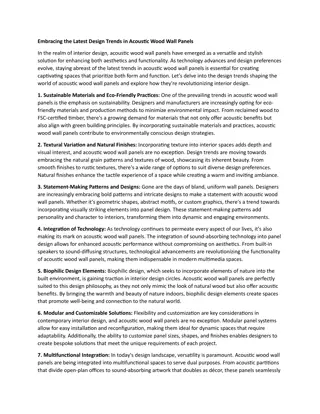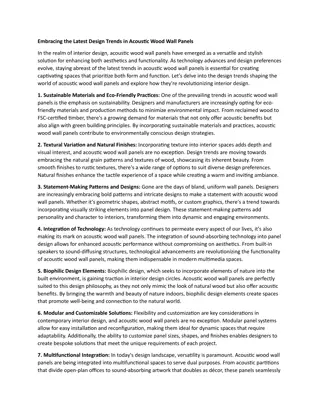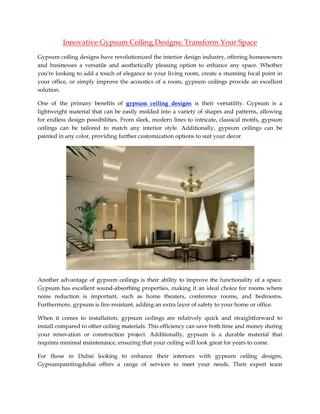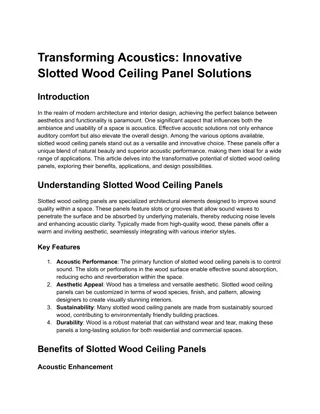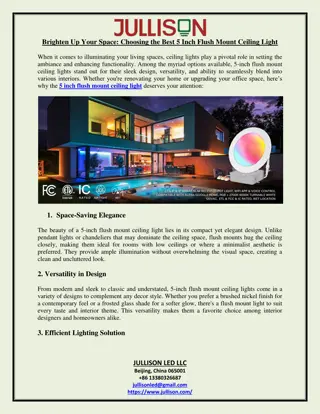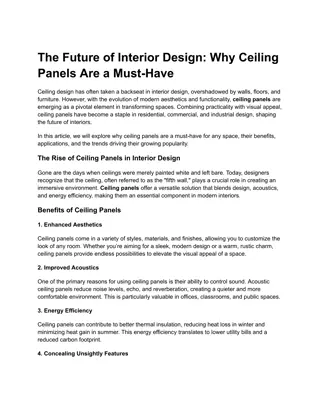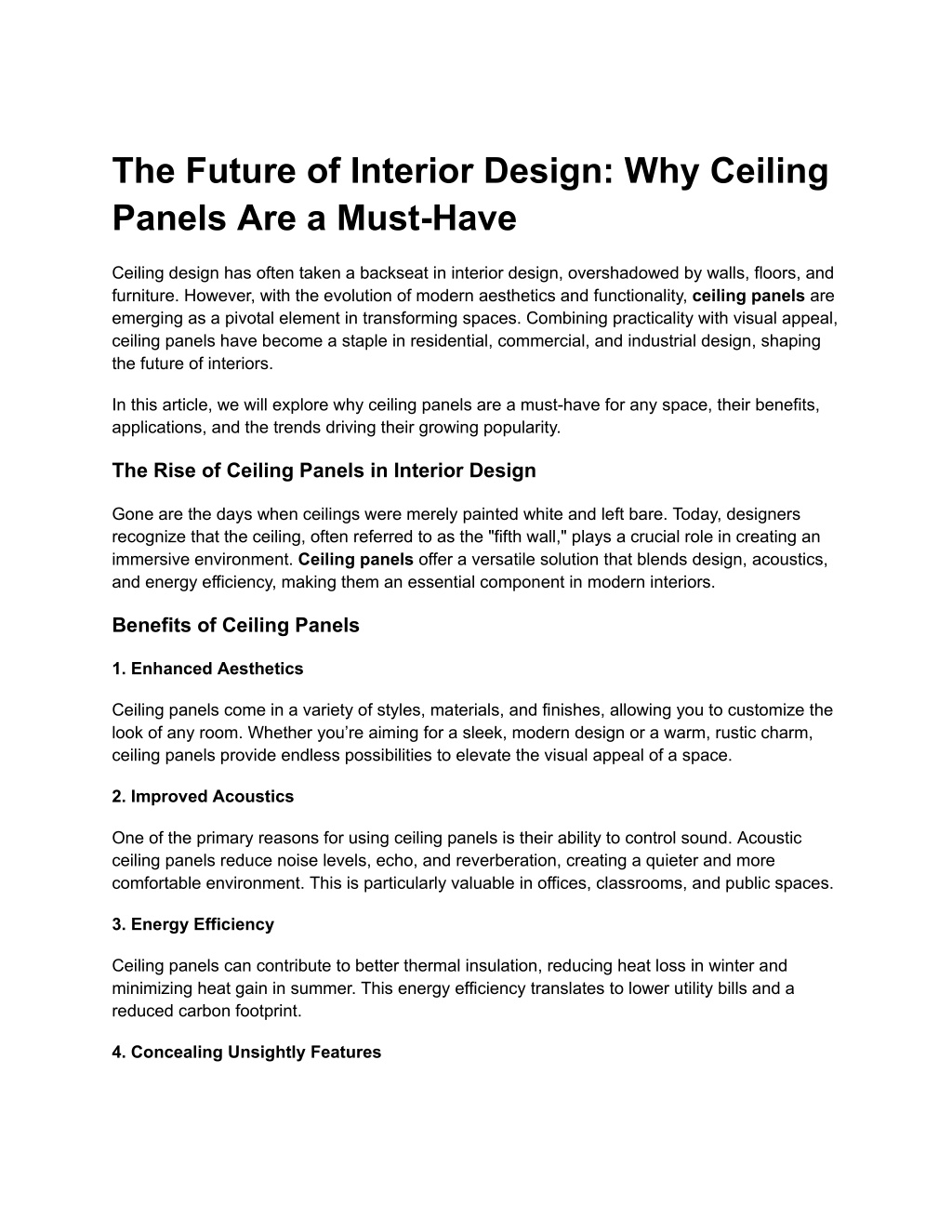
The Future of Interior Design: Why Ceiling Panels Are a Must-Have
Ceiling design has often taken a backseat in interior design, overshadowed by walls, floors, and furniture. However, with the evolution of modern aesthetics and functionality, ceiling panels are emerging as a pivotal element in transforming spaces. C
Download Presentation

Please find below an Image/Link to download the presentation.
The content on the website is provided AS IS for your information and personal use only. It may not be sold, licensed, or shared on other websites without obtaining consent from the author. Download presentation by click this link. If you encounter any issues during the download, it is possible that the publisher has removed the file from their server.
E N D
Presentation Transcript
The Future of Interior Design: Why Ceiling Panels Are a Must-Have Ceiling design has often taken a backseat in interior design, overshadowed by walls, floors, and furniture. However, with the evolution of modern aesthetics and functionality, ceiling panels are emerging as a pivotal element in transforming spaces. Combining practicality with visual appeal, ceiling panels have become a staple in residential, commercial, and industrial design, shaping the future of interiors. In this article, we will explore why ceiling panels are a must-have for any space, their benefits, applications, and the trends driving their growing popularity. The Rise of Ceiling Panels in Interior Design Gone are the days when ceilings were merely painted white and left bare. Today, designers recognize that the ceiling, often referred to as the "fifth wall," plays a crucial role in creating an immersive environment. Ceiling panels offer a versatile solution that blends design, acoustics, and energy efficiency, making them an essential component in modern interiors. Benefits of Ceiling Panels 1. Enhanced Aesthetics Ceiling panels come in a variety of styles, materials, and finishes, allowing you to customize the look of any room. Whether you re aiming for a sleek, modern design or a warm, rustic charm, ceiling panels provide endless possibilities to elevate the visual appeal of a space. 2. Improved Acoustics One of the primary reasons for using ceiling panels is their ability to control sound. Acoustic ceiling panels reduce noise levels, echo, and reverberation, creating a quieter and more comfortable environment. This is particularly valuable in offices, classrooms, and public spaces. 3. Energy Efficiency Ceiling panels can contribute to better thermal insulation, reducing heat loss in winter and minimizing heat gain in summer. This energy efficiency translates to lower utility bills and a reduced carbon footprint. 4. Concealing Unsightly Features
Ceiling panels are an excellent way to hide wires, ducts, and other mechanical systems while maintaining easy access for maintenance. They create a clean and organized look without compromising functionality. 5. Durability and Longevity High-quality ceiling panels are designed to withstand wear and tear, making them a durable option for both residential and commercial spaces. Many panels are resistant to moisture, fire, and even impact, ensuring longevity. Applications of Ceiling Panels 1. Residential Spaces In homes, ceiling panels are used to add character to living rooms, bedrooms, and kitchens. They can create a sense of height, incorporate lighting fixtures seamlessly, or provide a textured finish that enhances the ambiance. 2. Commercial Interiors Offices, retail stores, and restaurants benefit from the versatility of ceiling panels. Acoustic ceiling panels are especially popular in open-plan offices, where they help reduce noise distractions and promote productivity. 3. Public Spaces In auditoriums, libraries, and hospitals, ceiling panels improve sound quality and create a calming atmosphere. Their ability to integrate with lighting and HVAC systems makes them indispensable in such environments. 4. Industrial Settings Ceiling panels are used in factories and warehouses to optimize acoustics and thermal regulation. Specialized panels, such as fire-resistant or moisture-resistant types, are also common in these settings. Emerging Trends in Ceiling Panels 1. Eco-Friendly Materials Sustainability is a driving force in interior design, and ceiling panels made from recycled or renewable materials are gaining traction. Bamboo, cork, and recycled wood panels are popular choices for environmentally-conscious projects. 2. Custom Designs
From geometric patterns to 3D textures, ceiling panels are becoming more customizable than ever. Advanced manufacturing techniques allow for intricate designs that can turn a ceiling into a statement piece. 3. Smart Integration Ceiling panels are now being integrated with smart technologies, such as embedded LED lighting, speakers, and air purifiers. These innovations make ceiling panels multifunctional, enhancing their value in modern interiors. 4. Bold Colors and Finishes Neutral tones are giving way to bold colors and metallic finishes, making ceilings a focal point in interior design. Panels with glossy, matte, or textured finishes add depth and personality to spaces. Tips for Choosing Ceiling Panels 1. Understand Your Needs: Determine whether you need ceiling panels for aesthetics, acoustics, thermal insulation, or a combination of these features. 2. Choose the Right Material: Materials like wood, metal, and gypsum each offer unique benefits. Select one that aligns with your space and requirements. 3. Consider Installation: Modular ceiling panels are easier to install and replace, making them ideal for spaces that require frequent maintenance. 4. Focus on Maintenance: Opt for panels that are easy to clean and maintain, especially in high-traffic or industrial areas. Why Ceiling Panels Are the Future Ceiling panels are not just a trend; they represent a shift toward smarter, more sustainable design practices. Their ability to enhance both form and function ensures their place in the future of interior design. As technology and material innovation continue to advance, ceiling panels will offer even more creative possibilities, making them a must-have in every space. Conclusion Ceiling panels have redefined the role of ceilings in interior design. By addressing acoustics, energy efficiency, aesthetics, and sustainability, they offer a comprehensive solution for modern spaces. Whether you re designing a cozy home, a bustling office, or a large public venue, ceiling panels are an investment that pays off in both style and functionality. Elevate your interiors with the timeless appeal and practical benefits of ceiling panels a design choice that truly stands the test of time.


